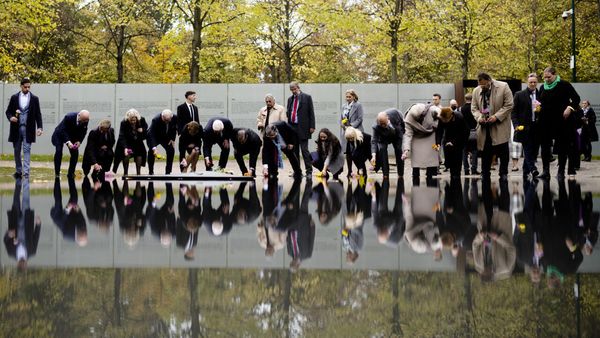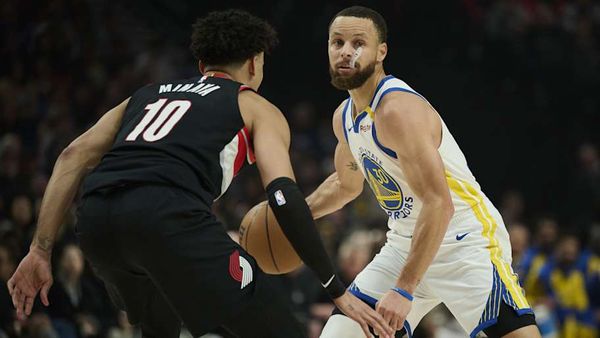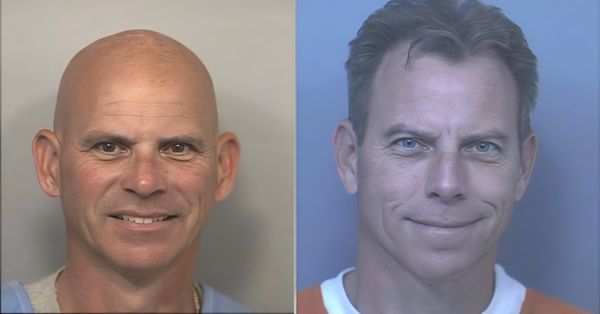
When animal behavior scientist and autism rights advocate Temple Grandin was beginning her career in livestock, one of her goals was to make the slaughtering process more humane for cattle. As she explains, her autism gave her an advantage in the process. Grandin studied the chutes that cows would walk down, and felt she could literally visualize what they visualized. Her autism allowed her to think in pictures and, through that process, empathize with animals to help make their experiences less emotionally painful.
That is an example of a visual thinker — their mind immediately turns to pictures. And in Grandin's case, being a visual thinker has put her at an advantage, she says — even though in other ways, being a divergent or neurodiverse thinker is often stigmatized.
Grandin is an object visualizer "who thinks in pictures and cannot do algebra. We're good at mechanics, art, animals and photography."
The idea of visual thinking is the focus of a new book by Grandin. Titled "Visual Thinkers: The Hidden Gifts of People Who Think In Pictures, Patterns and Abstractions," the book differentiates visual thinking from other types of autistic minds, which she divides into three categories: visual thinkers, musical/mathematical thinkers and verbal/logic thinkers.
Part of my interest in the book is that — while I am autistic like Grandin and have found solace in her commentary on how those on the spectrum think differently — I am not a visual thinker but a verbal thinker. This perhaps speaks to the diversity of minds that characterize those on the spectrum, and how we are not a single mass of similarly-minded neurodiverse people.
Interestingly, while she and I bonded over shared experiences — Grandin had similar issues with social rejection as an autistic person — her autistic mind operates differently. At the same age when I was swimming in a world of facts, Grandin was wielding her burgeoning gifts as an animal scientist and artist to draw and discuss horses whenever she could. As she told me, she is an object visualizer "who thinks in pictures and cannot do algebra. We're good at mechanics, art, animals and photography." Grandin's mind conjured up vivid images and was inclined toward mechanical work.
Like me, Grandin's peers mocked her for repetitive speech patterns and being "nerdy." When she displayed autistic traits as a young child, her parents hired a speech therapist and provided mentors throughout her life. Grandin has stated that she is grateful to have had supportive teachers and other authority figures throughout her childhood, although she still dealt with bullying and rejection as a teenager.
Yet as Grandin explains in "Visual Thinkers," these years of social torment also helped her develop into the internationally renowned scientist and activist that she is today. Because she was allowed to have hands-on experience learning about the animal industry, she applied her autistic brain in a way that empowered her to develop new technologies and approaches for reducing animal suffering in the livestock trade. Indeed, during her formative years, Grandin had many opportunities to utilize her intellectual powers in constructive ways. Only a year after she was expelled for throwing a book at a child who was taunting her, Grandin took a giant step toward her calling by spending a summer at an Arizona ranch owned by her stepfather's sister. After she transferred to a different school, she was mentored by a science teacher under whose tutelage she developed the squeeze box, a deep-pressure device that can calm people who are hypersensitive.
"I'm an extreme object visualizer. And everything I think about is a picture. Like when I told you about the three people fixing the escalator? I'm seeing it right now."
Because Grandin was surrounded by opportunities to use her autistic mind, she was able to make the world a better place. In "Visual Thinkers," Grandin expresses hope that other autistic individuals can receive the privileges that allowed her to realize her potential.
She argues that Western education systems are ill-serving autistic children who could contribute to society in important ways — particularly visual thinkers who, as engineers and problem-solvers, could repair our crumbling infrastructure — and advocates more shop classes and more programs that expose students directly to subjects that could fan the flames of interest in them. In addition, Grandin deplores the ongoing mistreatment of autistic individuals in all walks of life, from students whose teachers reject their unique ways of learning to adults who struggle to find employment because bosses only see their idiosyncrasies and not their gifts. Finally, she offers those who are not visual thinkers an opportunity to step into the mind of a visual thinker.
I am one of the people who needed that opportunity — because while I am indeed autistic, I am not autistic in the same way as Temple Grandin. That, perhaps, is the other valuable message of this book: not all autistic people are alike.
The following interview has been edited for clarity and length.
Both in this book and in your other work, you stress the importance of hands-on education and the type of teaching that focuses on technical skills. Can you elaborate on why this type of education is particularly important for neurodivergent people who are also visual thinkers?
We have a gigantic shortage of high-end skilled trades. In the first part of the book, I write about a trip I did in 2019, and this is when I realized that there were things we didn't make anymore. I went to two state-of-the-art pork plants, a state-of-the-art poultry plant. And in all three of those plants, most of the equipment came from Holland. Then the final stop was the Steve Jobs Theater with the structural glass walls, and also the Apple Mothership Building. Those structural glass walls were from Italy and Germany and the carbon fiber roof was from Dubai. Then later on I found out that the state-of-the-art electronic chip-making machine also comes from Holland. We are paying a price for taking out shop classes and other skilled trades classes 25 years ago.
Another big mistake that industry made about 25 years ago was shutting down in-house engineering departments. In the short run it was cheaper to contract that work out, but now it's coming back to bite us. And I know people that were autistic, dyslexic or ADHD, that build equipment for me, that built lots of equipment, that barely graduated from high school and have taken some shop classes. They're in their sixties now and they're selling stuff all around the world. I also am a big proponent of all kinds of hands-on classes. That's gonna include theater, music, art, cooking, sewing, woodworking. And then people can try out lots of different things.
To what extent do you think this problem involves education systems not understanding neurodivergency? Because it seems like if administrators understood that different people think in different ways they wouldn't, for instance, deemphasize shop class.
I talk about three kinds of thinking in the book. I talk about the object visualizer, like me, who thinks in pictures and cannot do algebra. We're good at mechanics, art, animals and photography. Then you have the visual spatial, more mathematical mind, that is super-good at computer programming and mathematics. There is a pattern I'm seeing all the time where either a parent or a teacher will come to me and say "My eight-year-old or 10-year-old can just look at the formulas and do it in his head, and the school won't let him do it in his head." But that's the way the kid thinks! They don't solve the math problems the same way. And a lot of those kids that are really smart in math need to be moved ahead.
"I've worked with people where some mechanical piece of equipment is the most important thing in their life. If the waterworks is the thing that that person really cares about, then the waterworks is going to work."
And some of those kids are neurodivergent. Not all of 'em, but some of them are. And I'm especially concerned about screening out my kind of mind because the people that built a lot of the equipment for me, they can't do algebra either. It is too abstract. And yet we need these skills. I've been on several rather dicey elevators lately because they haven't been serviced. I've been checking out the people who fix elevators and escalators. Just today, I was walking through the airport. There were four people fixing an escalator, and three out of four were older with gray hair. Well, what's going to happen when they retire? That's an issue. Who's going to fix the elevators and the escalators? Who is going to keep the waterworks running or prevent the wires from falling off the powers? We have got infrastructure that is falling apart right now.
I'm glad you brought that up, because one of my questions involves your chapter about disaster responses. What I found fascinating about that chapter is that it seems like you are foreseeing a future where infrastructure is going to crumble, supply chains are going to deteriorate. Climate change is going to create all kinds of problems. We are going to need object visual thinkers to help solve those problems.
We also need object visual thinkers because, when I think about myself, I am what I do. I've worked with people where some mechanical piece of equipment is the most important thing in their life. If the waterworks is the thing that that person really cares about, then the waterworks is going to work, and you need to have a waterworks that works or you're not going to have any water that's safe to drink in the houses.
This is something where those decisions were made 20 years ago, but I didn't realize how bad it was until I did that trip. Mainly, with the meat plants, I've worked with beef. Beef we actually still know how to build. But they're getting close to retirement too. The pork and the poultry, we've lost it.
Now I want to focus on the other types of thinkers that you describe in your book. If you were to explain this conceptually — how there are different types of neurodivergent thinkers — if you were to explain that to a neurotypical, how would you do so effectively?
Most people are mixtures of different kinds of thinking, but then you get somebody who has a different kind of mind. Like me, for an example, I'm an extreme object visualizer. And everything I think about is a picture. Like when I told you about the three people fixing the escalator? I'm seeing it right now. And I was going down the other escalator that was working. You see it's not abstract and everything is a picture. The mathematical thinker, the visual spatial thinker, thinks in patterns. They're the people that make it possible for us to use a video phone. The programmers that make that kind of technology possible. You see there are actually two kinds of object visualizers — like me, which are more art and mechanics, and then there is the mathematical thinker that would program the computers, that does the abstract math part.
"Just say that some people are geniuses in things like math and computer programming, but you might call Michelangelo a genius in art. I'd rather put it that way."
I get a magazine called Chemistry Engineering News, and there is amazing stuff they're doing with chemistry right now. I don't understand a lot of the math, but I understand the purpose of it. And that's being done with a mathematical, visual spatial mind. And then one of the chapters in the books reviews the research that the object visualizer and the extreme visual spatial math mathematician, they're actually opposites. And then a lot of people are mixtures. Lots of people are mixtures.
The thing I often ask is, what would happen to Albert Einstein today? He had no language until age three. What would happen to Steve Jobs, being bullied in school while he was fooling around the next door neighbor's garage? That was really helpful. What would happen to Michelangelo, a 12-year-old school dropout, if he hadn't grown up around great art and stone cutting tools? Because the other thing is that for kids to develop an interest in things, they have to be exposed to those things. I get asked all the time how to end up the cattle industry. I was exposed to it as a teenager. I'm a big believer in getting the neurodiverse kids exposed to lots of different things so they can discover what they're good at. I was always exposed to musical instruments. I was not good at that, but I was exposed to it. Another kid is going pick up that instrument and just play it immediately, but you don't know until you expose them. Shop classes are not for everybody, but I tried computer programming. Bill Gates and I had access to the exact same computer system. He could do it. I had to drop the class.
At one point in your book you discussed geniuses, people who literally qualify, and you make it clear that it's very difficult to quantify what counts as a genius. I was thinking because if someone describes themselves as a genius to others, they're considered to be bragging. Do you think if someone wants to assess themselves or another person as a genius, what criteria should they use, in your opinion? How should one define genius? At least in terms of conventional usage?
Just say that some people are geniuses in things like math and computer programming, but you might call Michelangelo a genius in art. I'd rather put it that way.
What about someone who is a genius at playing video games, or someone who is a genius at playing the harmonica?
There are many different things. You can get really good at one particular thing. One of the things that I was good at was drawing, and one of the things that was done with me when I was a child was to broaden the drawing. Instead of drawing horse heads over and over again, they would say, "Let's draw the whole horse. Let's draw the stable." Take that interest in drawing and broaden it so it's not so fixated. When I was in high school, I had a little sign painting business, and one of the things I had to learn is I had to make signs that other people would want. My first paid sign job was for a hair salon. I had to make a sign that they would want and would not have horses on it.







